Characterizing Current THD’s Dependency on Solar Irradiance and Supraharmonics Profiling for a Grid-Tied Photovoltaic Power Plant
Abstract
1. Introduction
- 1.
- Development of a three-phase PV-DER grid-tied model in Matlab Simulink;
- 2.
- Investigating different irradiance profile and record the grid current’s THD;
- 3.
- Analyzing the results towards finding any correlation between input irradiance and output THD;
- 4.
- Understanding the SH contribution to the grid current’s THD in several cases.
- 1.
- Low irradiance values in the early morning and late afternoon are related to consistent injection of high harmonics by grid-tied PV-DERs irrespective of load on the grid.
- 2.
- The mid-day fluctuation of the irradiance is related to harmonic injection for a shorter period of time, with high notches over that time.
- 3.
- The THD correlation with the input irradiance is similar to supraharmonics that exist in a PV microgrid.
- 4.
- A real-time simulation and field PQ data validate the model’s response.
2. Total Harmonic Distortion at the Point of Common Coupling
2.1. Research Methodology
2.2. Grid-Tied DER Model with Three-Phase Load
2.3. FIU’s Solar Canopy
2.4. DER Penetration Impact on Supraharmonics
3. Results and Discussion
3.1. Irradiance Impact on Current THD at the PCC
3.2. Real-Time Simulation by OPAL-RT
3.3. Revolution PQ Recorder Current THD Measurement at FIU’s PCC
3.4. Supraharmonics Magnitude at 2 kHz Boundary
4. Conclusions and Future Work
Author Contributions
Funding
Institutional Review Board Statement
Informed Consent Statement
Data Availability Statement
Acknowledgments
Conflicts of Interest
Abbreviations
| BESS | Battery energy storage system |
| DAS | Data acquisition system |
| DER | Distributed energy resource |
| DIAF | Distributed incremental adaptive filter |
| FIU | Florida International University |
| FLPID | Fuzzy logic proportional–integral–differential |
| G2G | Grid-to-grid |
| GHI | Global horizontal index |
| HF | High-frequency |
| HIL | Hardware-in-loop |
| LCL | Inductor–capacitor–inductor |
| LMMN | Least-mean mixed-norm |
| LV-MV-HV | (Low-medium-high) voltage |
| MG | Microgrid |
| MPP | Maximum power point |
| NPC | Neutral point clamped |
| PCC | Point of common coupling |
| PMI | Power Monitor Inc. |
| POI | Point of interconnection |
| P&O | Perturb and observe |
| PV | Photovoltaic |
| RTDS | Real-time digital simulation |
| SH | Supraharmonics |
| SHC | Second harmonic content |
| STC | Standard test conditions |
| THD | Total harmonic distortion |
| VSC | Voltage source converter |
References
- Hussan, M.R.; Sarwar, M.I.; Sarwar, A.; Tariq, M.; Ahmad, S.; Shah Noor Mohamed, A.; Khan, I.A.; Ali Khan, M.M. Aquila Optimization Based Harmonic Elimination in a Modified H-Bridge Inverter. Sustainability 2022, 14, 929. [Google Scholar] [CrossRef]
- Khan, R.A.; Farooqui, S.A.; Sarwar, M.I.; Ahmad, S.; Tariq, M.; Sarwar, A.; Zaid, M.; Ahmad, S.; Shah Noor Mohamed, A. Archimedes Optimization Algorithm Based Selective Harmonic Elimination in a Cascaded H-Bridge Multilevel Inverter. Sustainability 2021, 14, 310. [Google Scholar] [CrossRef]
- Khajeh, K.G.; Solatialkaran, D.; Zare, F.; Mithulananthan, N. Harmonic Analysis of Multi-Parallel Grid- Connected Inverters in Distribution Networks: Emission and Immunity Issues in the Frequency Range of 0–150 kHz. IEEE Access 2020, 8, 56379–56402. [Google Scholar] [CrossRef]
- Kan, S.; Ruan, X.; Dang, H.; Zhang, L.; Huang, X. Second Harmonic Current Reduction in Front-End DC–DC Converter for Two-Stage Single-Phase Photovoltaic Grid-Connected Inverter. IEEE Trans. Power Electron. 2019, 34, 6399–6410. [Google Scholar] [CrossRef]
- Elkholy, A. Harmonics assessment and mathematical modeling of power quality parameters for low voltage grid connected photovoltaic systems. Solar Energy 2019, 183, 315–326. [Google Scholar] [CrossRef]
- Babu P, N.; Guerrero, J.M.; Siano, P.; Peesapati, R.; Panda, G. An Improved Adaptive Control Strategy in Grid-Tied PV System with Active Power Filter for Power Quality Enhancement. IEEE Syst. J. 2021, 15, 2859–2870. [Google Scholar] [CrossRef]
- Yaghoobi, J.; Zare, F.; Rehman, T.; Rathnayake, H. Analysis of High Frequency Harmonics in Distribution Networks: 9 – 150 kHz. In Proceedings of the 2019 IEEE International Conference on Industrial Technology (ICIT), Melbourne, VIC, Australia, 13–15 February 2019; pp. 1229–1234. [Google Scholar] [CrossRef]
- Reveles-Miranda, M.; Flota-Bañuelos, M.; Chan-Puc, F.; Ramirez-Rivera, V.; Pacheco-Catalán, D. A Hybrid Control Technique for Harmonic Elimination, Power Factor Correction, and Night Operation of a Grid-Connected PV Inverter. IEEE J. Photovolt. 2020, 10, 664–675. [Google Scholar] [CrossRef]
- Li, D.; Wang, T.; Pan, W.; Ding, X.; Gong, J. A comprehensive review of improving power quality using active power filters. Electr. Power Syst. Res. 2021, 199, 107389. [Google Scholar] [CrossRef]
- Darmawardana, D.; Perera, S.; Robinson, D.; Meyer, J.; Jayatunga, U. Important Considerations in Development of PV Inverter Models for High Frequency Emission (Supraharmonic) Studies. In Proceedings of the 2020 19th International Conference on Harmonics and Quality of Power (ICHQP), Dubai, United Arab Emirates, 6–7 July 2020; pp. 1–6. [Google Scholar] [CrossRef]
- Novitskiy, A.; Schlegel, S.; Westermann, D. Measurements and Analysis of Supraharmonic Influences in a MV/LV Network Containing Renewable Energy Sources. In Proceedings of the 2019 Electric Power Quality and Supply Reliability Conference (PQ) & 2019 Symposium on Electrical Engineering and Mechatronics (SEEM), Kärdla, Estonia, 12–15 June 2019; pp. 1–6. [Google Scholar] [CrossRef]
- Ali, A.; Almutairi, K.; Padmanaban, S.; Tirth, V.; Algarni, S.; Irshad, K.; Islam, S.; Zahir, M.H.; Shafiullah, M.; Malik, M.Z. Investigation of MPPT techniques under uniform and non-uniform solar irradiation condition—A retrospection. IEEE Access 2020, 8, 127368–127392. [Google Scholar] [CrossRef]
- Ali, A.; Almutairi, K.; Malik, M.Z.; Irshad, K.; Tirth, V.; Algarni, S.; Zahir, M.H.; Islam, S.; Shafiullah, M.; Shukla, N.K. Review of online and soft computing maximum power point tracking techniques under non-uniform solar irradiation conditions. Energies 2020, 13, 3256. [Google Scholar] [CrossRef]
- Haq, S.; Biswas, S.P.; Hosain, M.K.; Islam, M.R.; Rahman, M.A.; Muttaqi, K.M. A Modified PWM Scheme to Improve the Power Quality of NPC Inverter Based Solar PV Fed Induction Motor Drive for Water Pumping. In Proceedings of the 2021 IEEE Industry Applications Society Annual Meeting (IAS), Vancouver, BC, Canada, 10–14 October 2021; pp. 1–6. [Google Scholar]
- Singh, Y.; Singh, B.; Mishra, S. Control of Single-Phase Distributed PV-Battery Microgrid for Smooth Mode Transition with Improved Power Quality. IEEE Trans. Ind. Appl. 2022, 58, 6286–6296. [Google Scholar] [CrossRef]
- Chilipi, R.; Al Sayari, N.; Alsawalhi, J.Y. Control of single-phase solar power generation system with universal active power filter capabilities using least mean mixed-norm (LMMN)-based adaptive filtering method. IEEE Trans. Sustain. Energy 2019, 11, 879–893. [Google Scholar] [CrossRef]
- Singh, B.; Kumar, S. Distributed incremental adaptive filter controlled grid interactive residential photovoltaic-battery based microgrid for rural electrification. IEEE Trans. Ind. Appl. 2020, 56, 4114–4123. [Google Scholar] [CrossRef]
- Singh, J.K.; Al Jaafari, K.; Behera, R.K.; Al Hosani, K.; Muduli, U.R. Faster convergence controller with distorted grid conditions for photovoltaic grid following inverter system. IEEE Access 2022, 10, 29834–29845. [Google Scholar] [CrossRef]
- Nasr Esfahani, F.; Darwish, A.; Williams, B.W. Power converter topologies for grid-tied solar photovoltaic (PV) powered electric vehicles (EVs)—A comprehensive review. Energies 2022, 15, 4648. [Google Scholar] [CrossRef]
- Aghazadeh, A.; Davari, M.; Nafisi, H.; Blaabjerg, F. Grid integration of a dual two-level voltage-source inverter considering grid impedance and phase-locked loop. IEEE J. Emerg. Sel. Top. Power Electron. 2019, 9, 401–422. [Google Scholar] [CrossRef]
- Beniwal, N.; Tafti, H.D.; Farivar, G.G.; Ceballos, S.; Pou, J.; Blaabjerg, F. A control strategy for dual-input neutral-point-clamped inverter-based grid-connected photovoltaic system. IEEE Trans. Power Electron. 2021, 36, 9743–9757. [Google Scholar] [CrossRef]
- Stonier, A.A.; Murugesan, S.; Samikannu, R.; Venkatachary, S.K.; Kumar, S.S.; Arumugam, P. Power quality improvement in solar fed cascaded multilevel inverter with output voltage regulation techniques. IEEE Access 2020, 8, 178360–178371. [Google Scholar] [CrossRef]
- Basu, T.S.; Maiti, S. A hybrid modular multilevel converter for solar power integration. IEEE Trans. Ind. Appl. 2019, 55, 5166–5177. [Google Scholar] [CrossRef]
- Wang, C.; Zhang, K.; Xiong, J.; Xue, Y.; Liu, W. An efficient modulation strategy for cascaded photovoltaic systems suffering from module mismatch. IEEE J. Emerg. Sel. Top. Power Electron. 2017, 6, 941–954. [Google Scholar] [CrossRef]
- Lashab, A.; Sera, D.; Hahn, F.; Camurca, L.; Terriche, Y.; Liserre, M.; Guerrero, J.M. Cascaded multilevel PV inverter with improved harmonic performance during power imbalance between power cells. IEEE Trans. Ind. Appl. 2020, 56, 2788–2798. [Google Scholar] [CrossRef]
- Debnath, A.; Olowu, T.O.; Roy, S.; Sarwat, A. Voltage Regulation and Battery Stress-Reduction Strategy for DC microgrid. In Proceedings of the 2021 6th IEEE Workshop on the Electronic Grid (eGRID), New Orleans, LA, USA, 8–10 November 2021; pp. 1–6. [Google Scholar] [CrossRef]
- Debnath, A.; Roy, S.; Olowu, T.O.; Parvez, I.; Sarwat, A. A Unified Controller for Hybrid PV-Battery system with DC Microgrid Voltage Regulation in Grid-connected and Islanding-mode. In Proceedings of the 2022 IEEE Industry Applications Society Annual Meeting (IAS), Detroit, MI, USA, 9–14 October 2022; pp. 1–6. [Google Scholar] [CrossRef]
- Debnath, A.; Olowu, T.O.; Roy, S.; Parvez, I.; Sarwat, A. Particle Swarm Optimization-based PID Controller Design for DC-DC Buck Converter. In Proceedings of the 2021 North American Power Symposium (NAPS), College Station, TX, USA, 14–16 November 2021; pp. 1–6. [Google Scholar] [CrossRef]
- Sarwat, A.; McCluskey, P.; Mazumder, S.K.; Russell, M.; Roy, S.; Tufail, S.; Dharmasena, S.; Stevenson, A. Reliability Assessment of Grid Connected Solar Inverters in 1.4 MW PV Plant from Anomalous Classified Real Field Data. Available online: https://mazumder.lab.uic.edu/wp-content/uploads/sites/504/2022/08/NAPS_paper_619.pdf (accessed on 5 January 2023).
- Li, S.; Fairbank, M.; Johnson, C.; Wunsch, D.C.; Alonso, E.; Proao, J.L. Artificial Neural Networks for Control of a Grid-Connected Rectifier/Inverter Under Disturbance, Dynamic and Power Converter Switching Conditions. IEEE Trans. Neural Netw. Learn. Syst. 2014, 25, 738–750. [Google Scholar] [CrossRef] [PubMed]
- Hoarcă, I.C. Mathematical modeling and simulation of PV systems Part I: Mathematical modeling and Simulink implementation. In Proceedings of the 2021 International Conference on Applied and Theoretical Electricity (ICATE), Craiova, Romania, 27–29 May 2021; pp. 1–6. [Google Scholar] [CrossRef]
- Raya-Armenta, J.M.; Ortega, P.R.; Bazmohammadi, N.; Spataru, S.V.; Vasquez, J.C.; Guerrero, J.M. An Accurate Physical Model for PV Modules With Improved Approximations of Series-Shunt Resistances. IEEE J. Photovolt. 2021, 11, 699–707. [Google Scholar] [CrossRef]
- Zhang, C.; Zhang, Y.; Su, J.; Gu, T.; Yang, M. Modeling and Prediction of PV Module Performance Under Different Operating Conditions Based on Power-Law I–V Model. IEEE J. Photovolt. 2020, 10, 1816–1827. [Google Scholar] [CrossRef]
- Zhong, C.; Li, H.; Zhou, Y.; Lv, Y.; Chen, J.; Li, Y. Virtual synchronous generator of PV generation without energy storage for frequency support in autonomous microgrid. Int. J. Electr. Power Energy Syst. 2022, 134, 107343. [Google Scholar] [CrossRef]
- Photovoltaics, D.G.; Storage, E. IEEE Application Guide for IEEE Std 1547™, IEEE Standard for Interconnecting Distributed Resources with Electric Power Systems; IEEE: Piscataway, NJ, USA, 2009. [Google Scholar]
- Siyuan, Z.; Jiannan, Z.; Zhen, M.; Xuanzhe, Z.; Yong, F.; Zhiqian, L.; Guangzheng, Y. A Novel Supraharmonics Measurement Method Based on Flexible Atom Filtering. In Proceedings of the 2019 4th International Conference on Intelligent Green Building and Smart Grid (IGBSG), Yichang, China, 6–9 September 2019; pp. 113–117. [Google Scholar] [CrossRef]
- Yalcin, T.; Özdemir, M.; Kostyla, P.; Leonowicz, Z. Analysis of supra-harmonics in smart grids. In Proceedings of the 2017 IEEE International Conference on Environment and Electrical Engineering and 2017 IEEE Industrial and Commercial Power Systems Europe (EEEIC / I&CPS Europe), Milan, Italy, 6–9 June 2017; pp. 1–4. [Google Scholar] [CrossRef]
- OPAR-RT Energy Conversion. Available online: https://www.opal-rt.com/energy-conversion-controls/ (accessed on 16 November 2022).
- OPAR-RT eFPGA. Available online: https://www.opal-rt.com/systems-efpgasim/ (accessed on 16 November 2022).
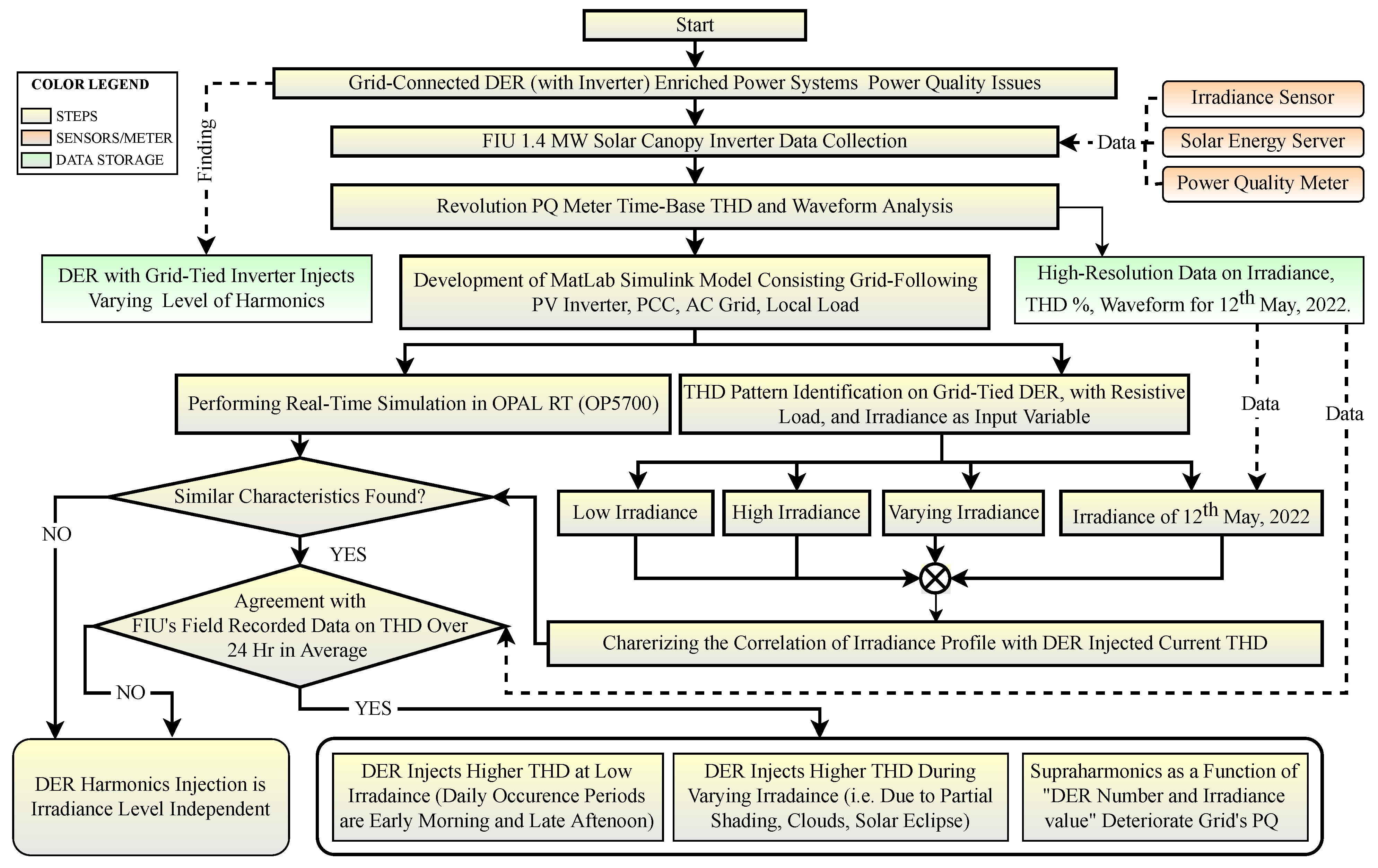
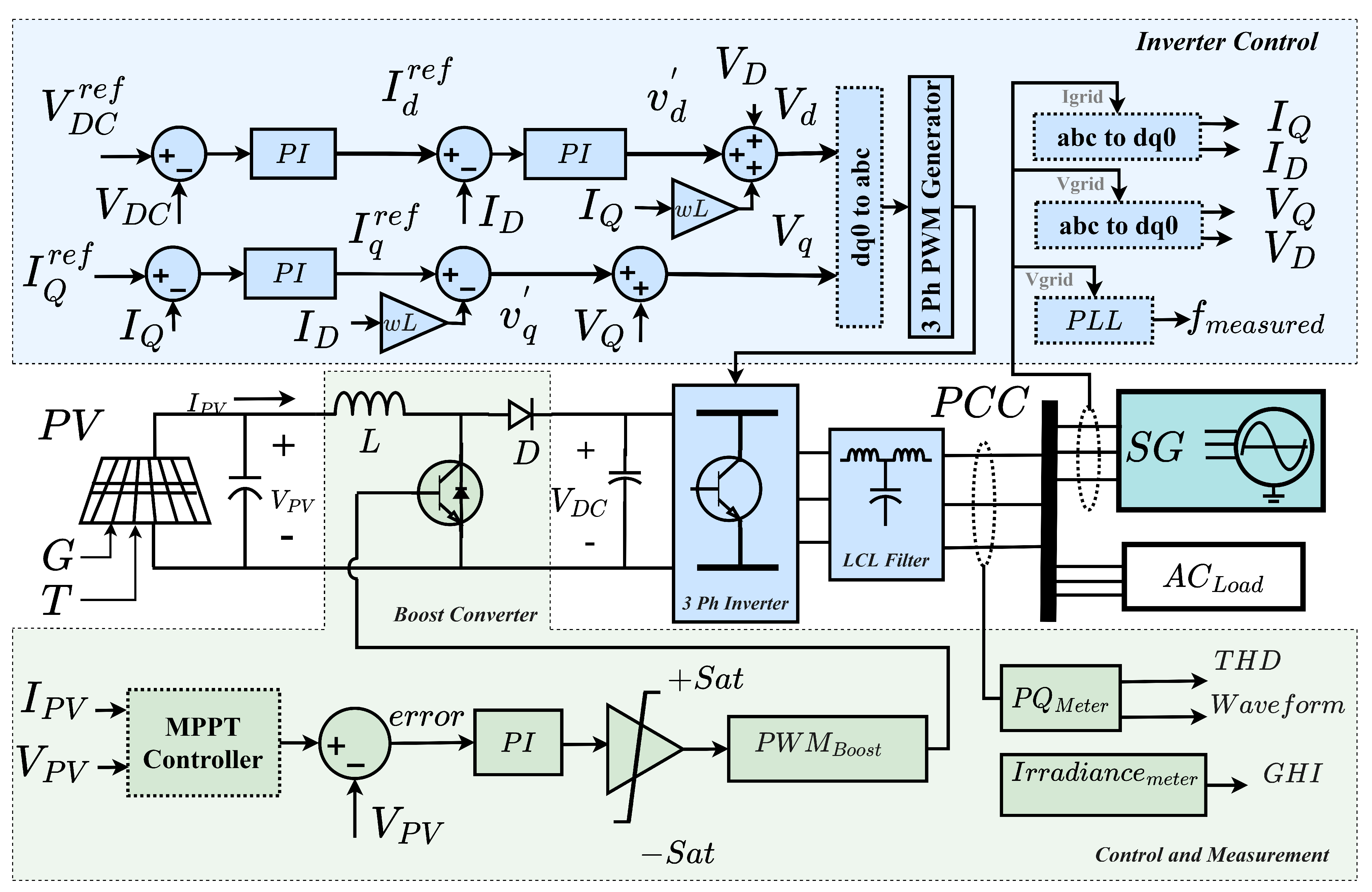
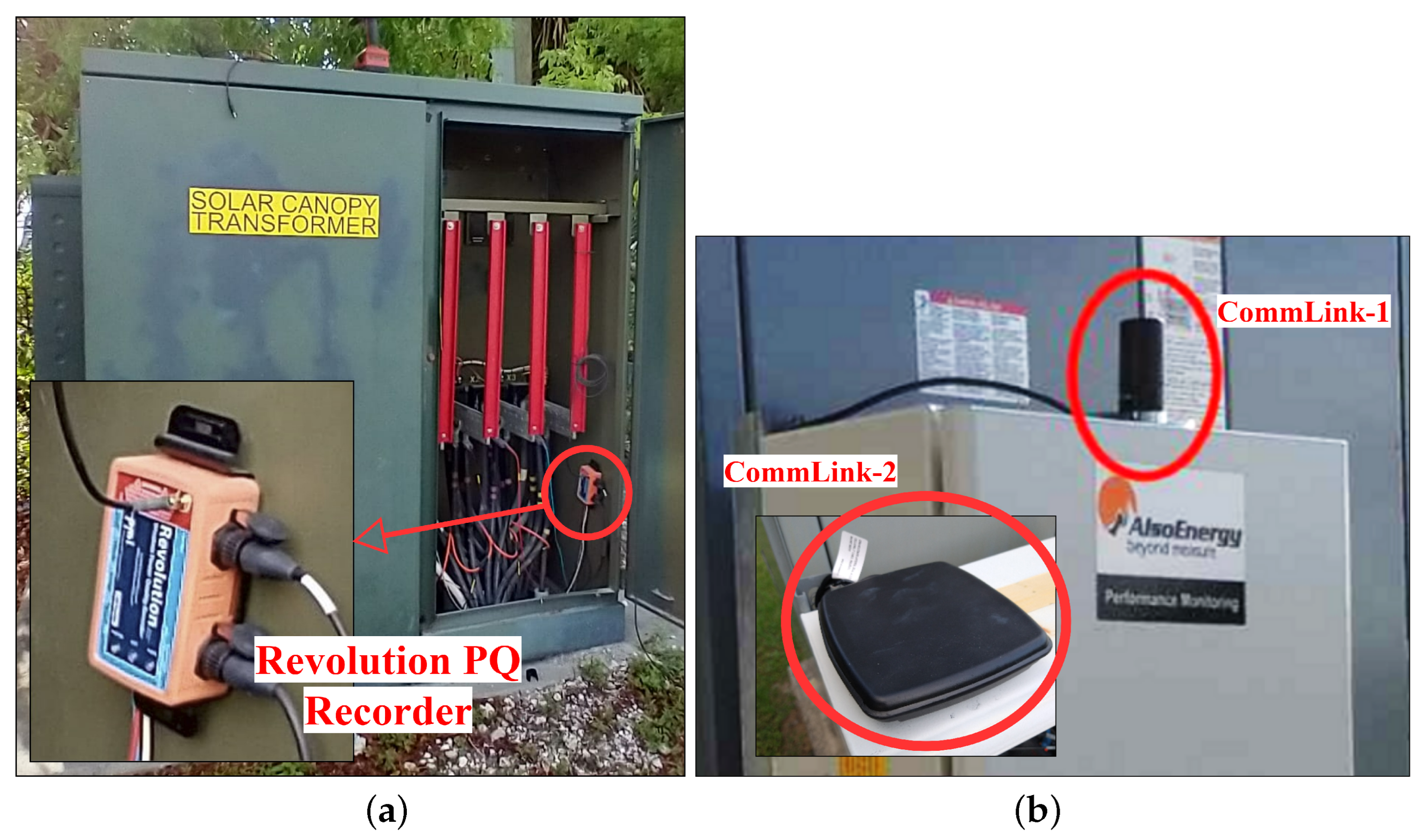
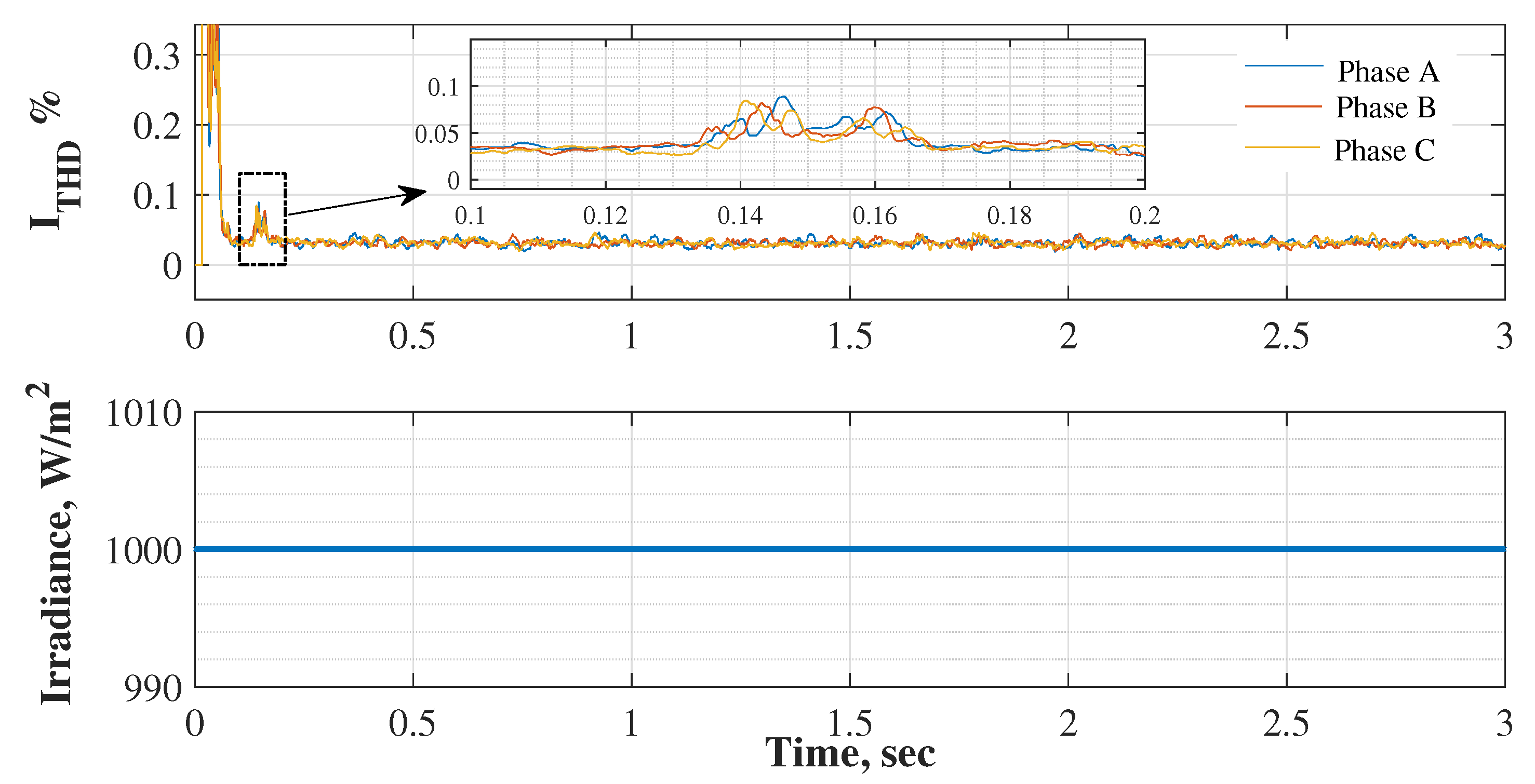
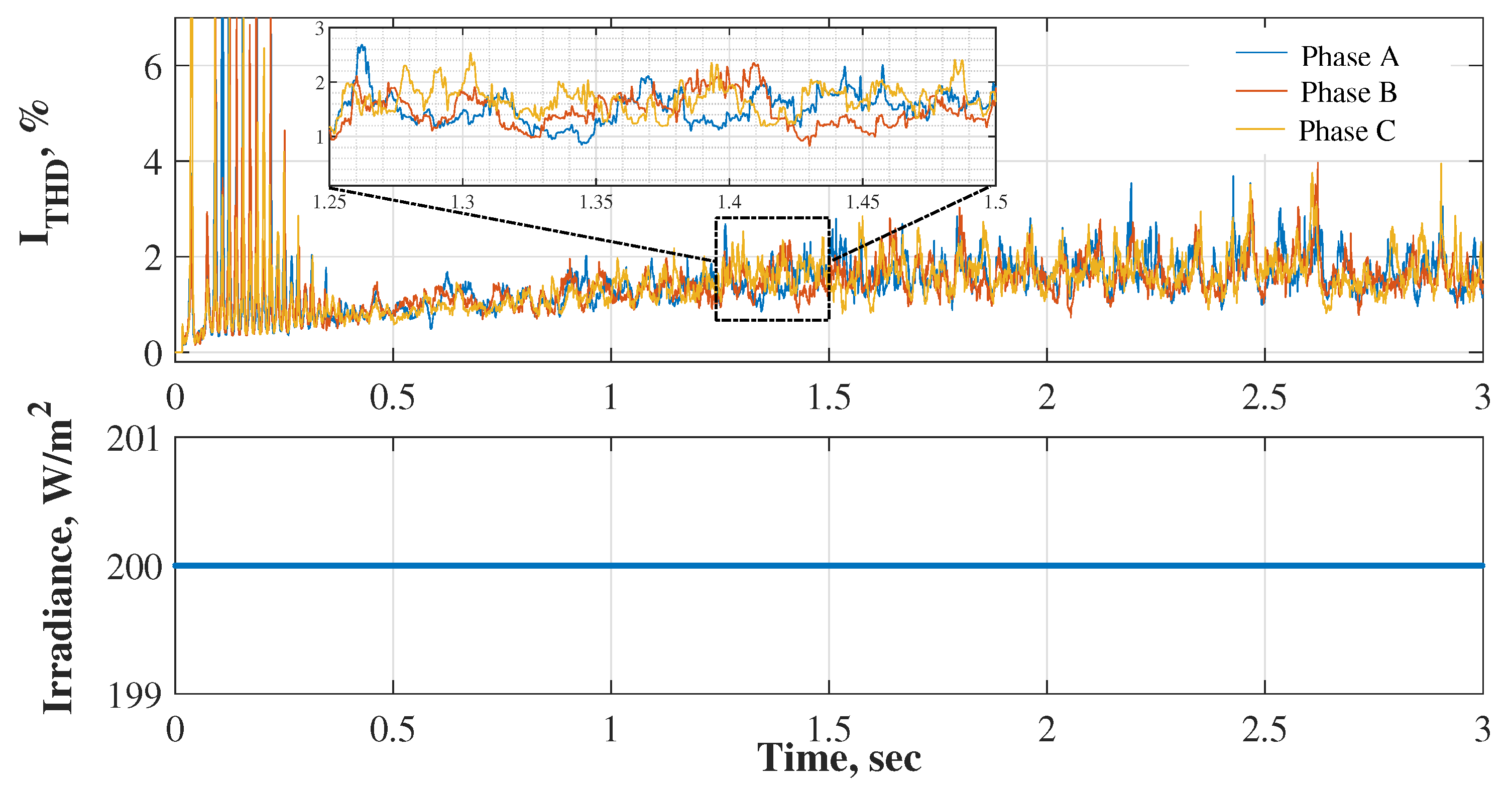
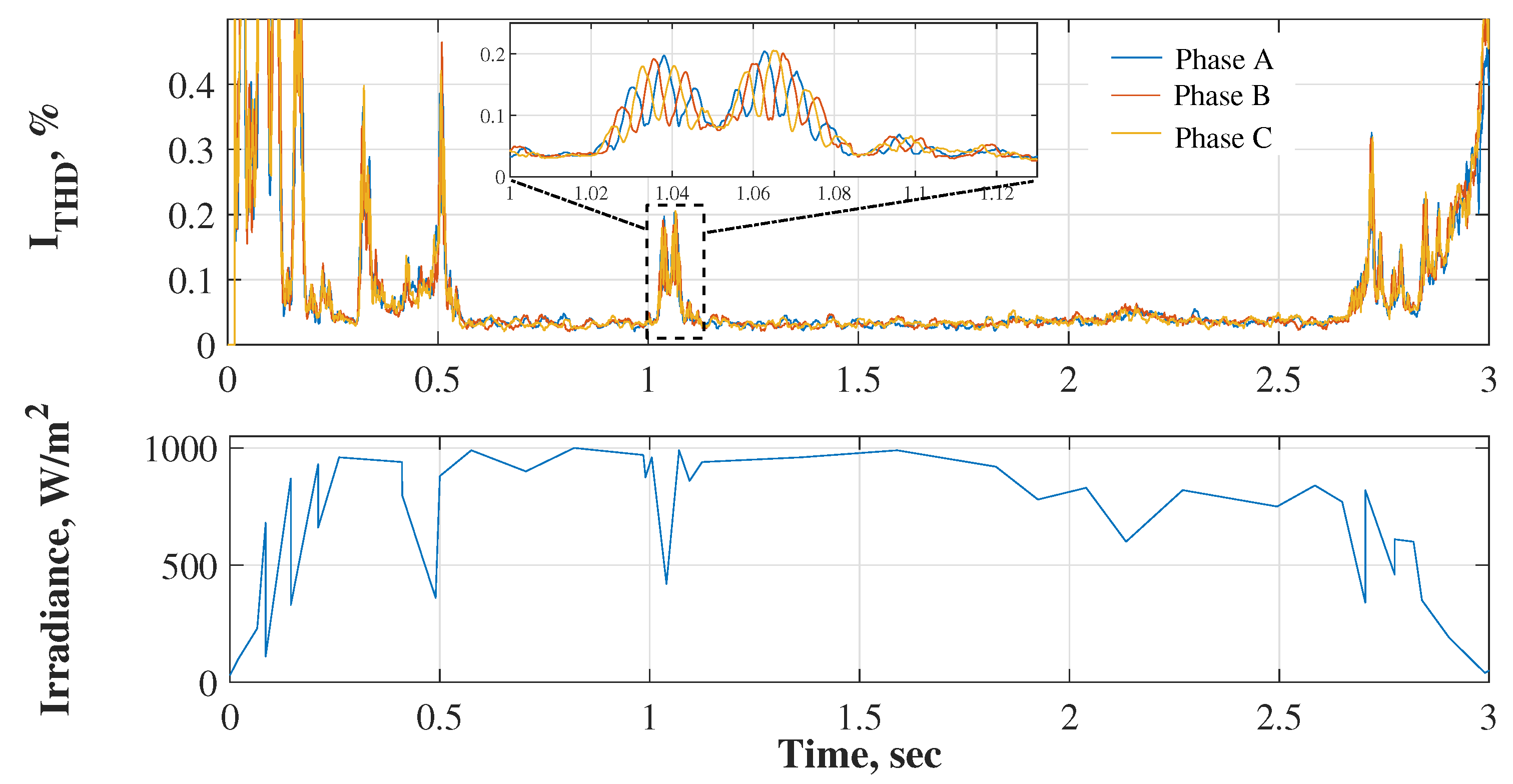

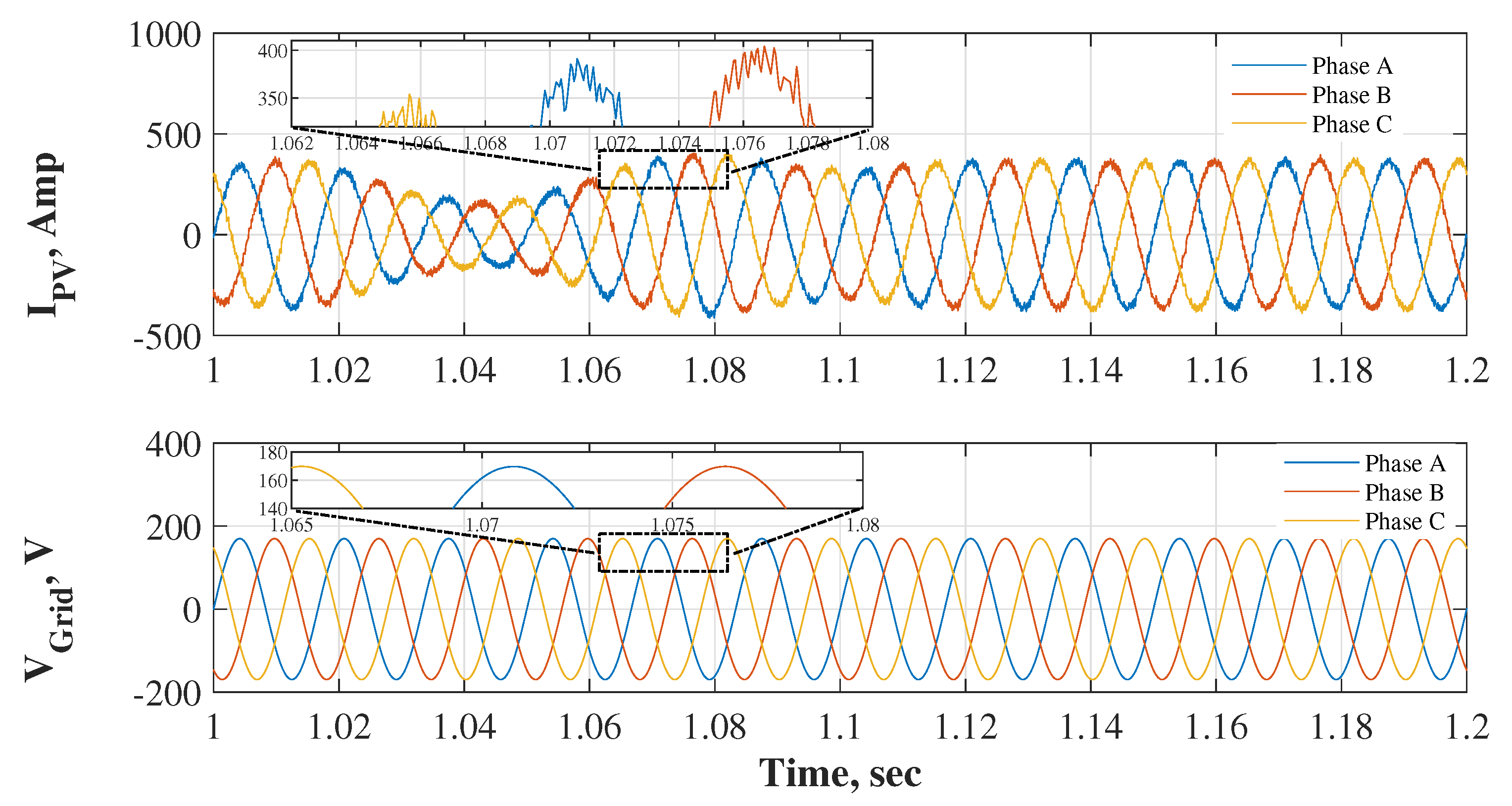
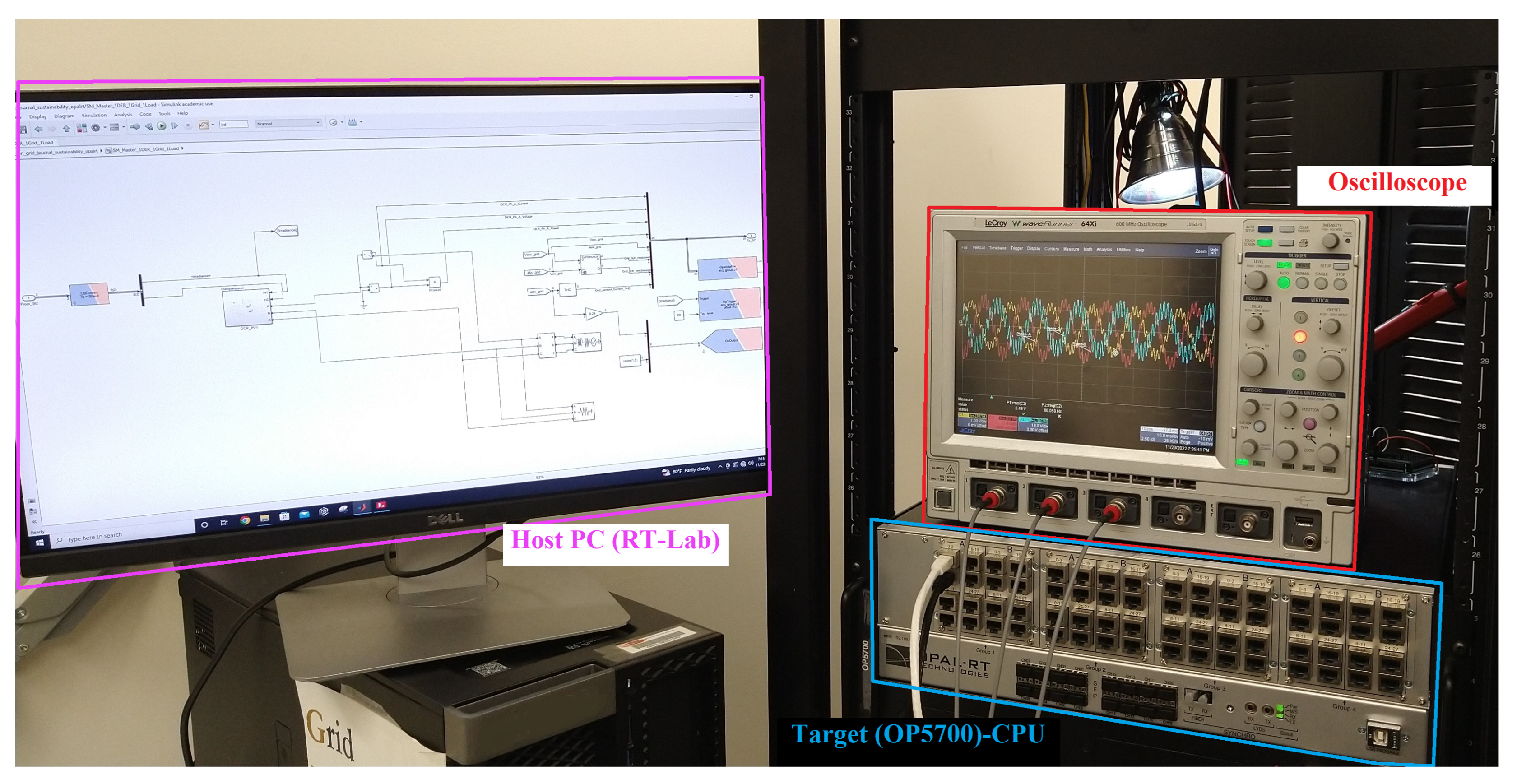
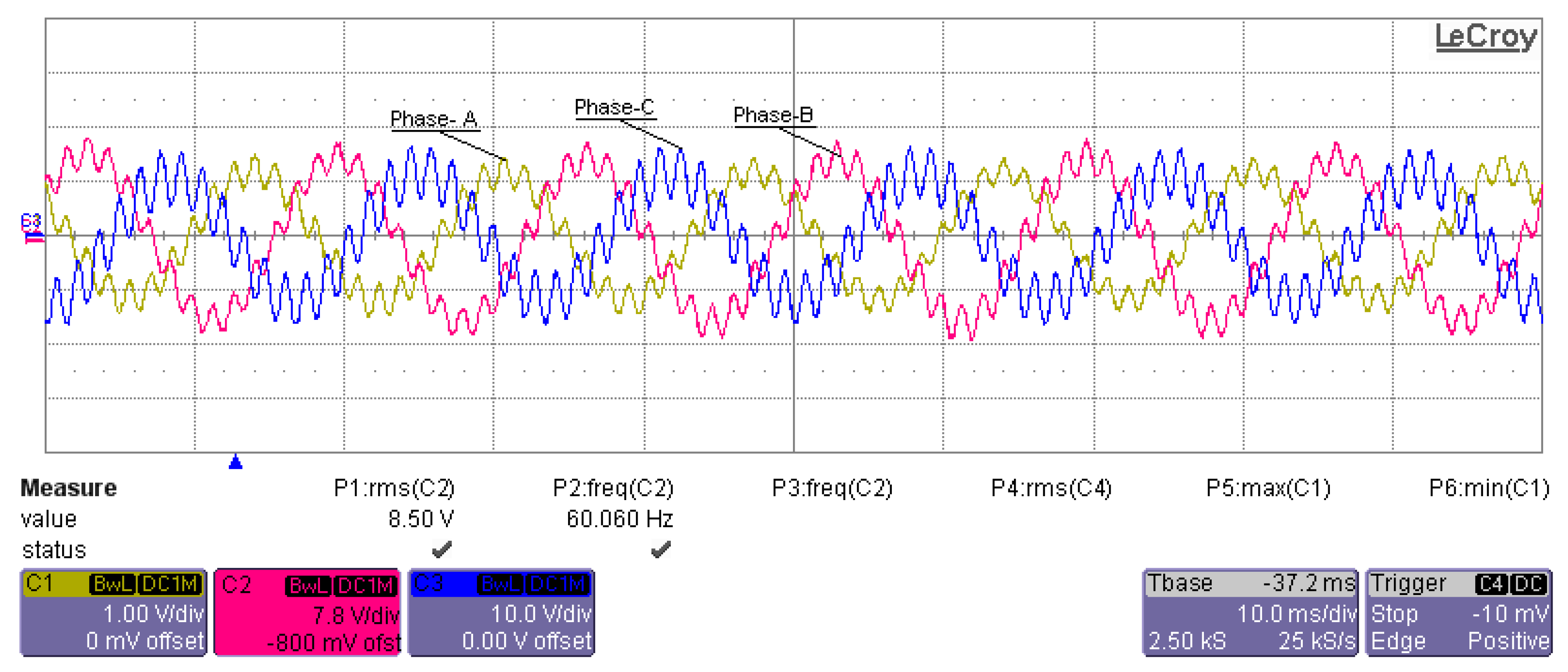
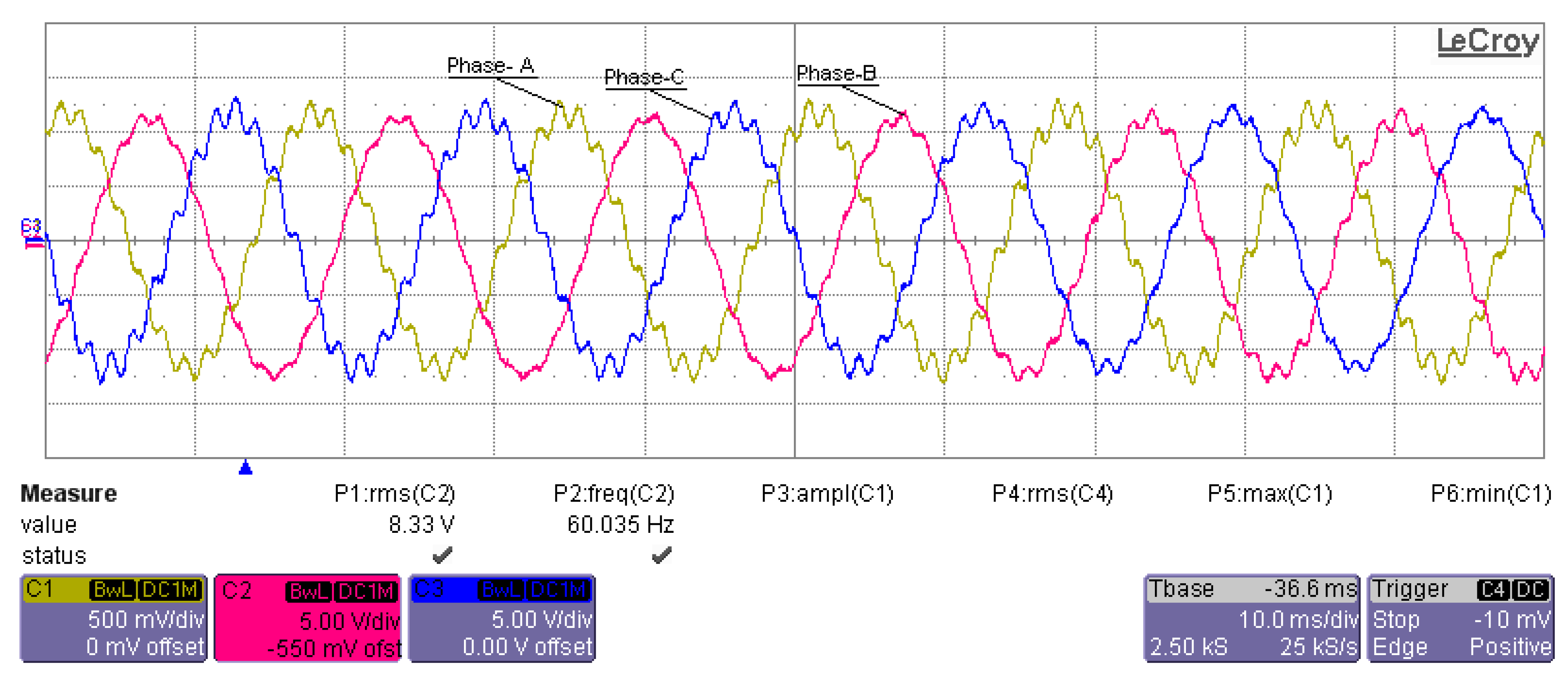
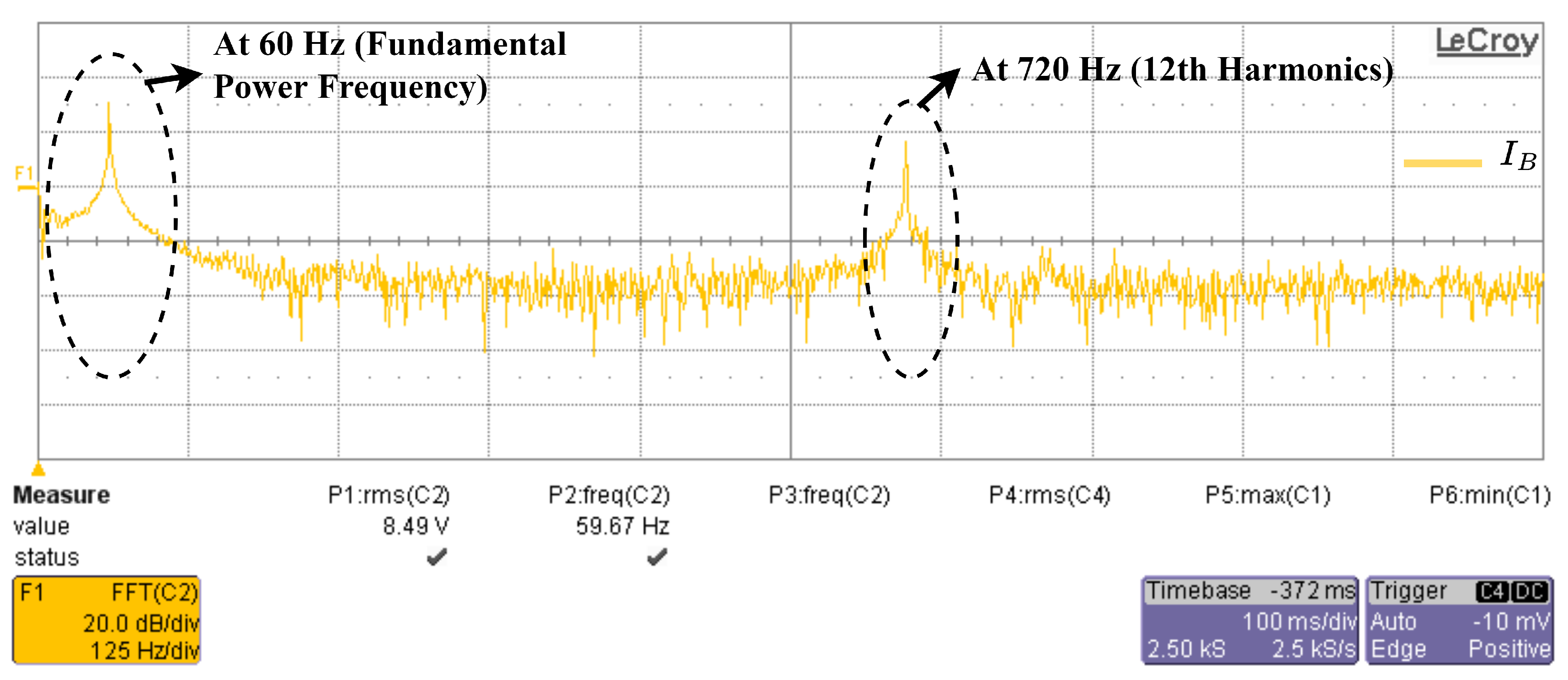
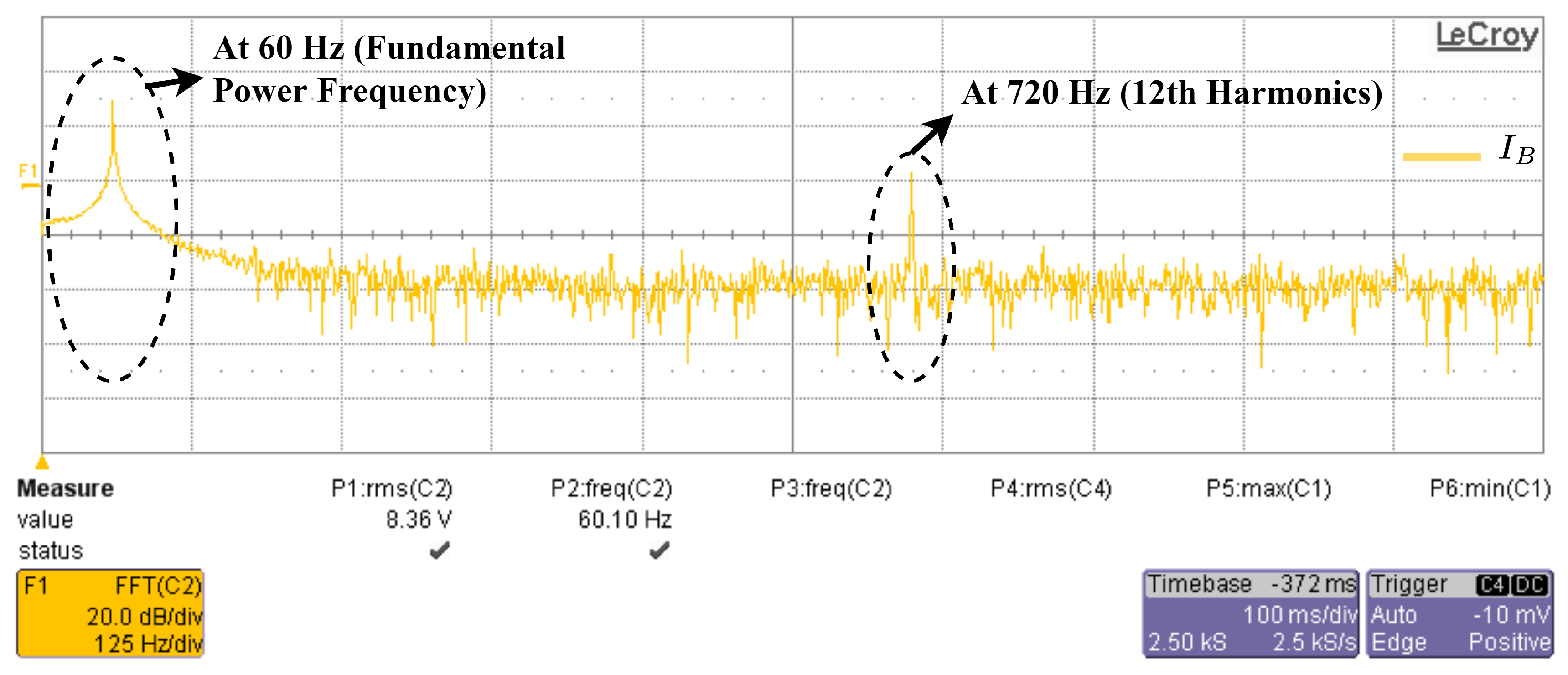
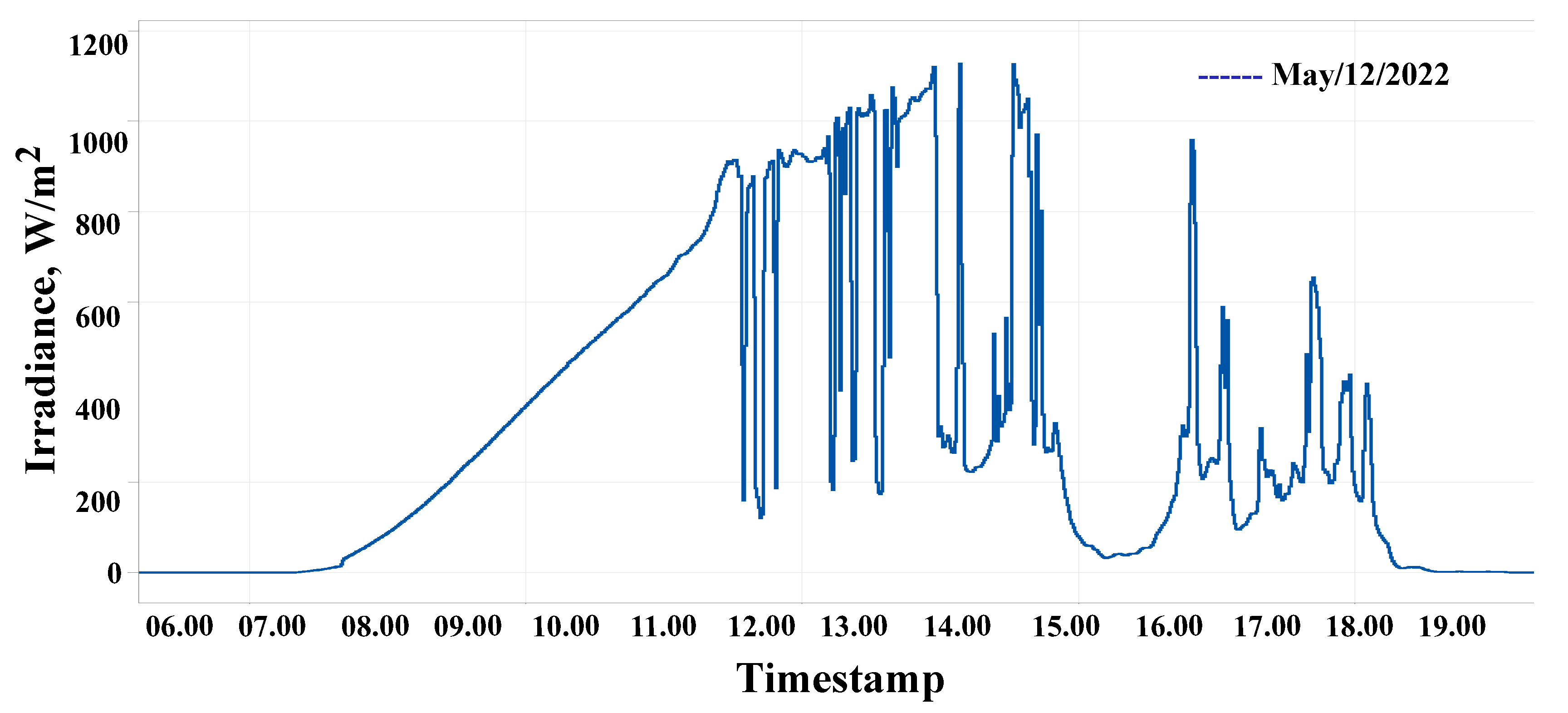
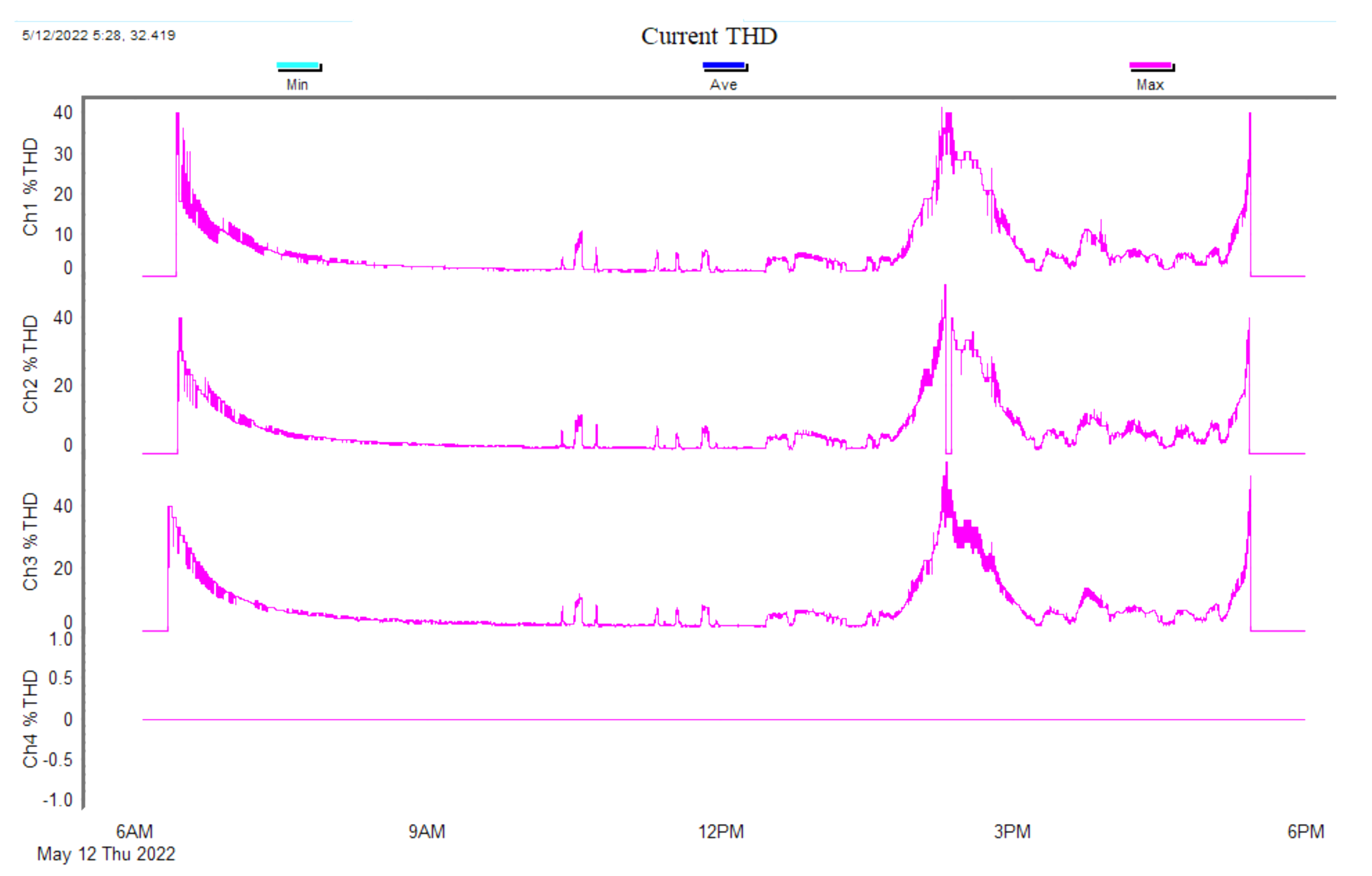
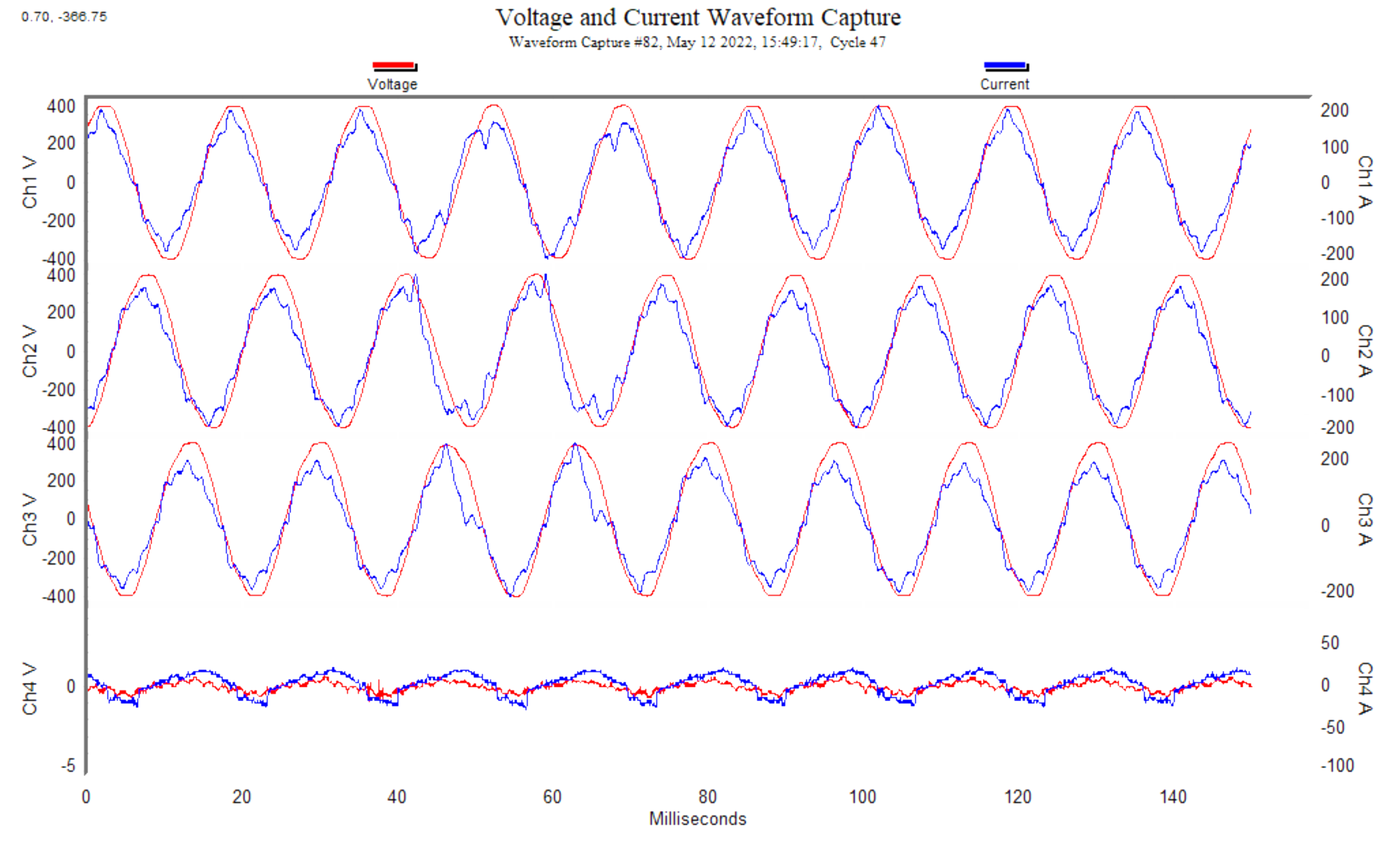
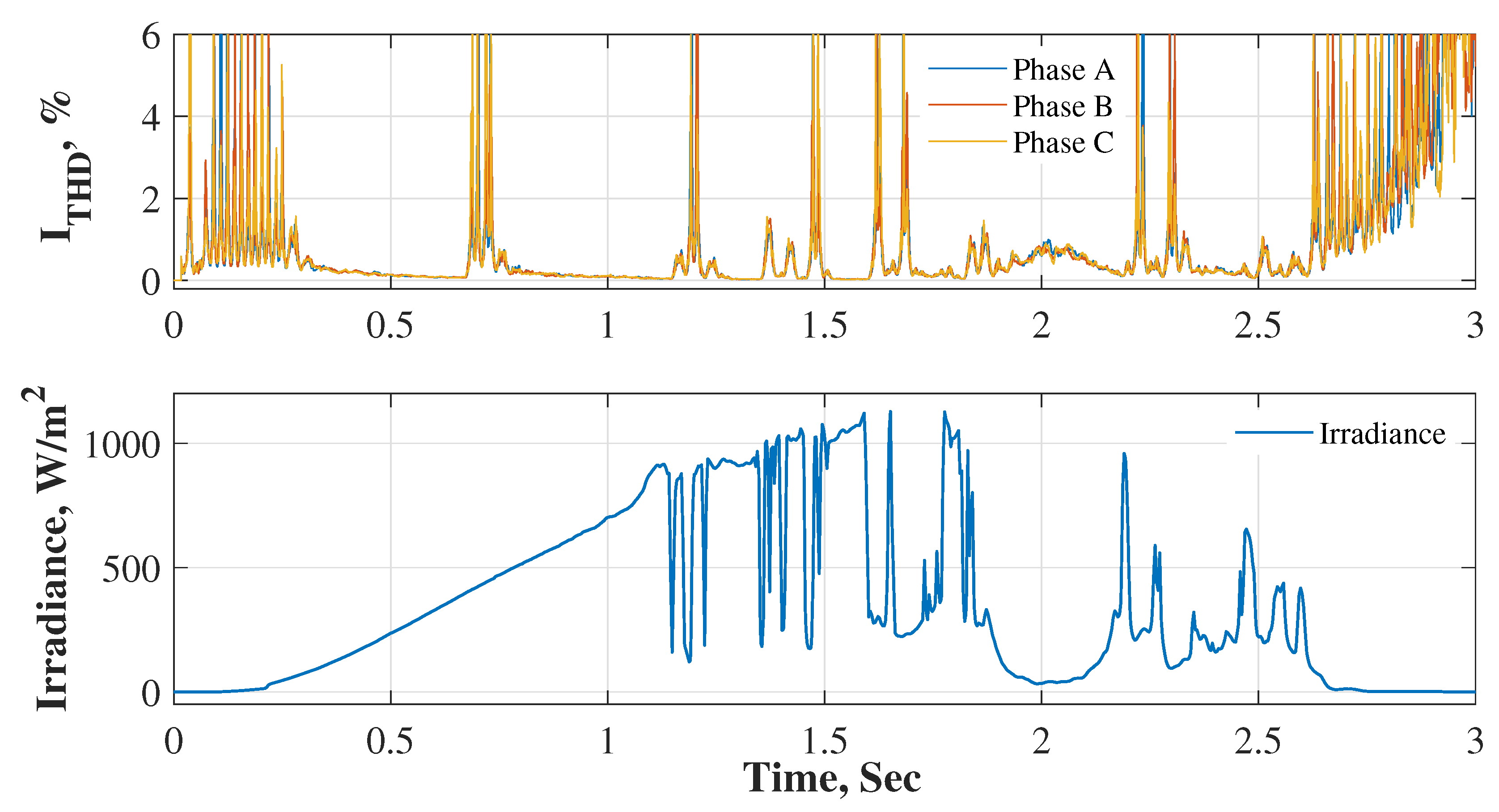
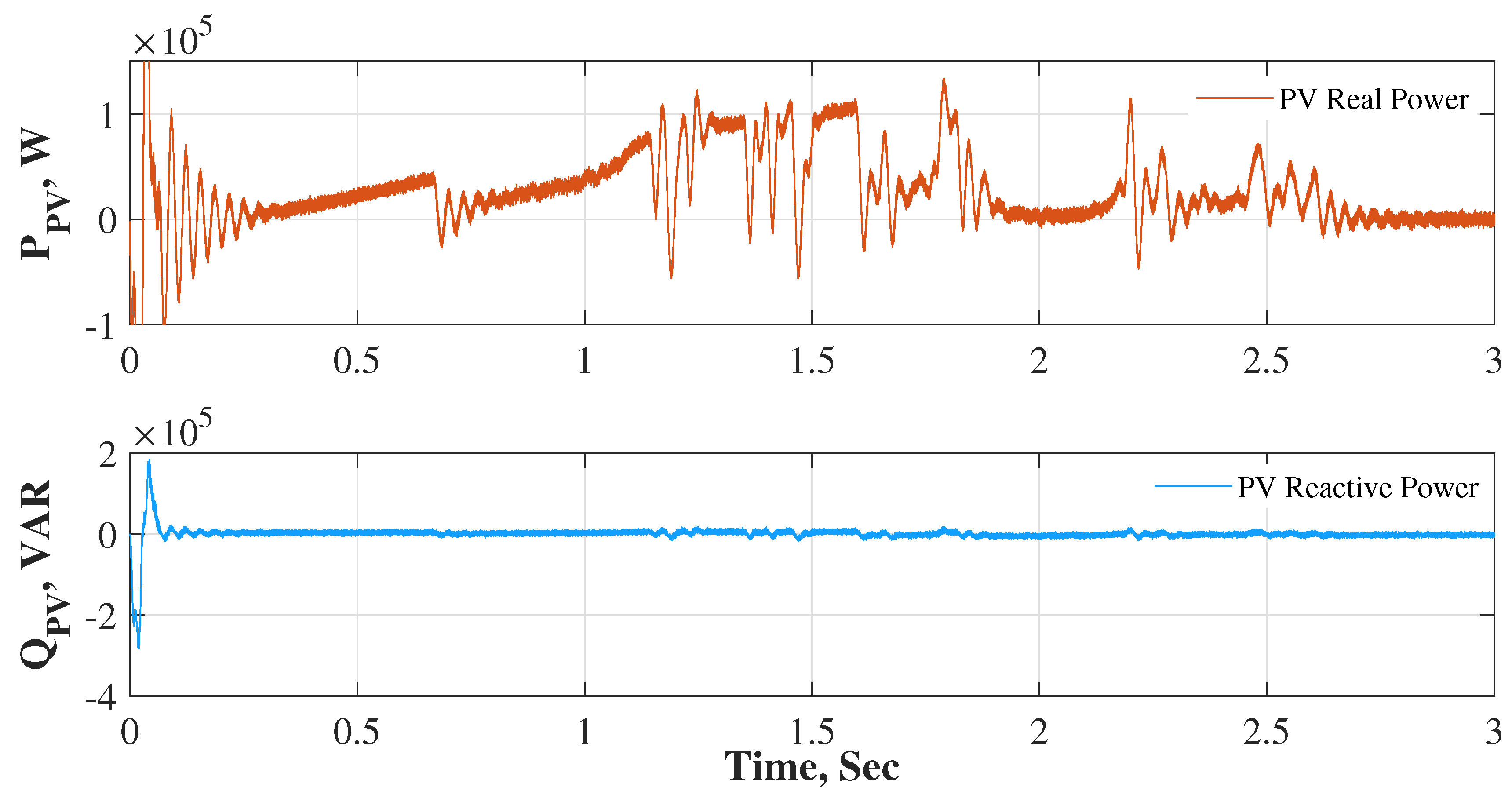
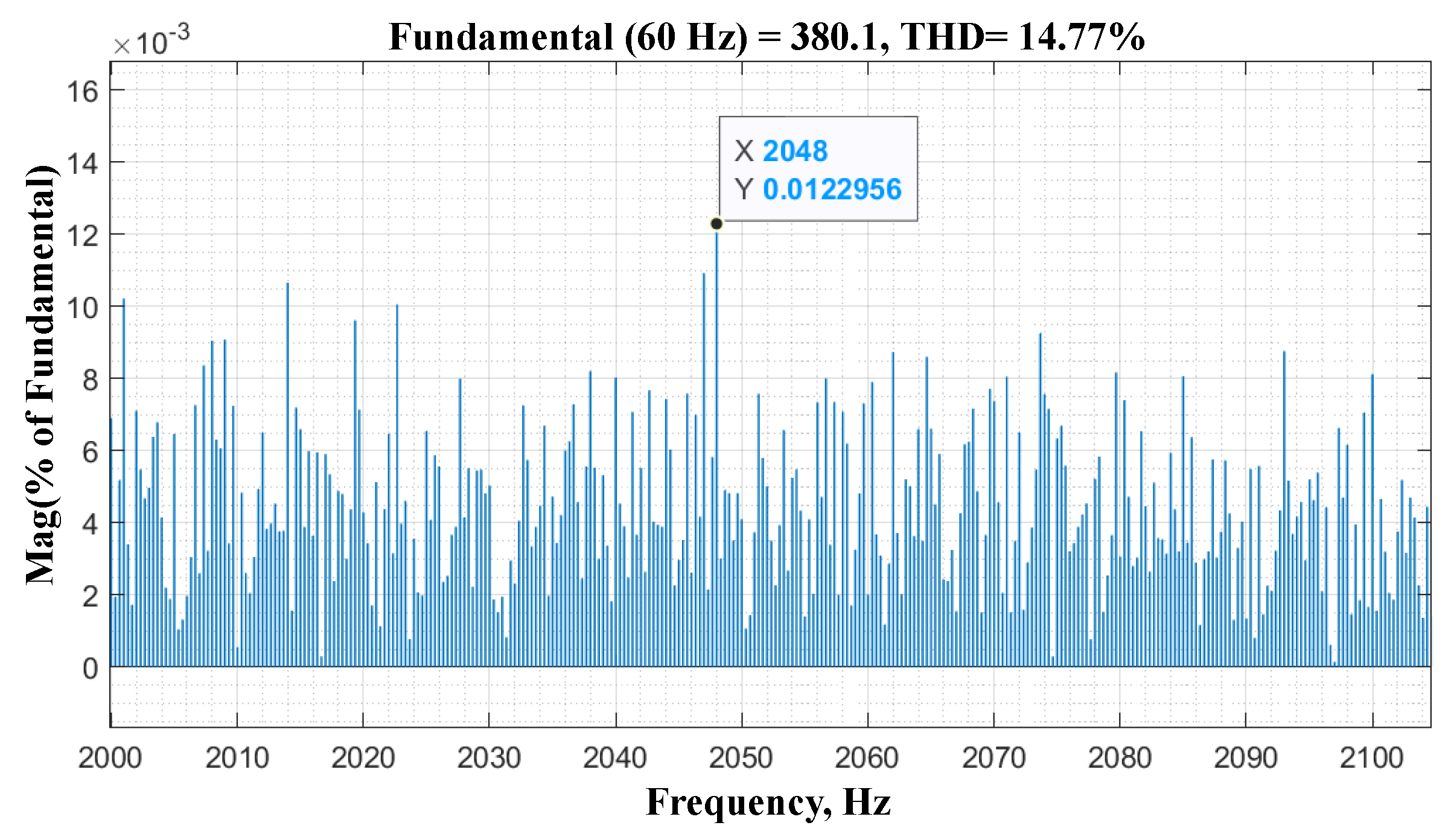
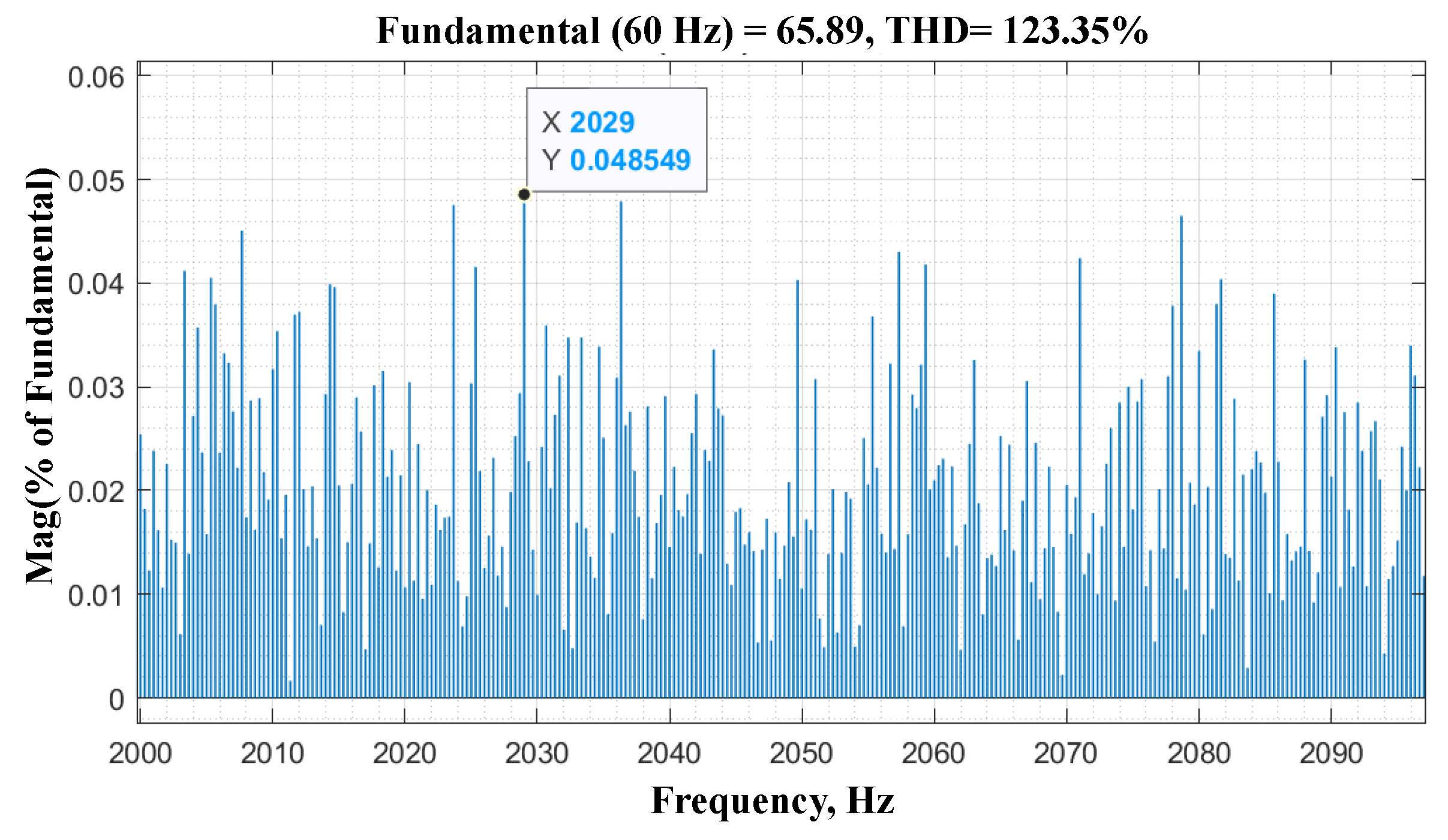
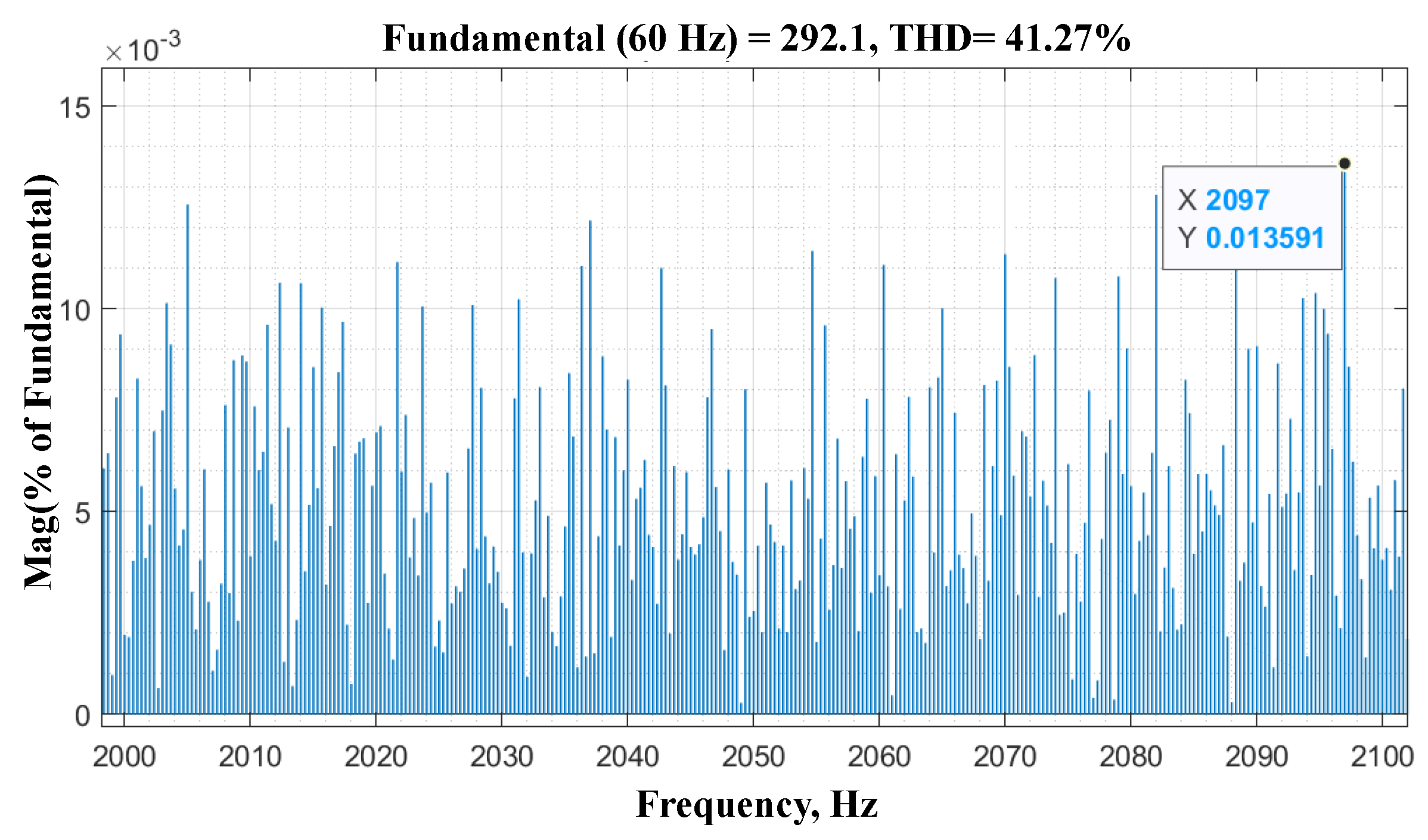
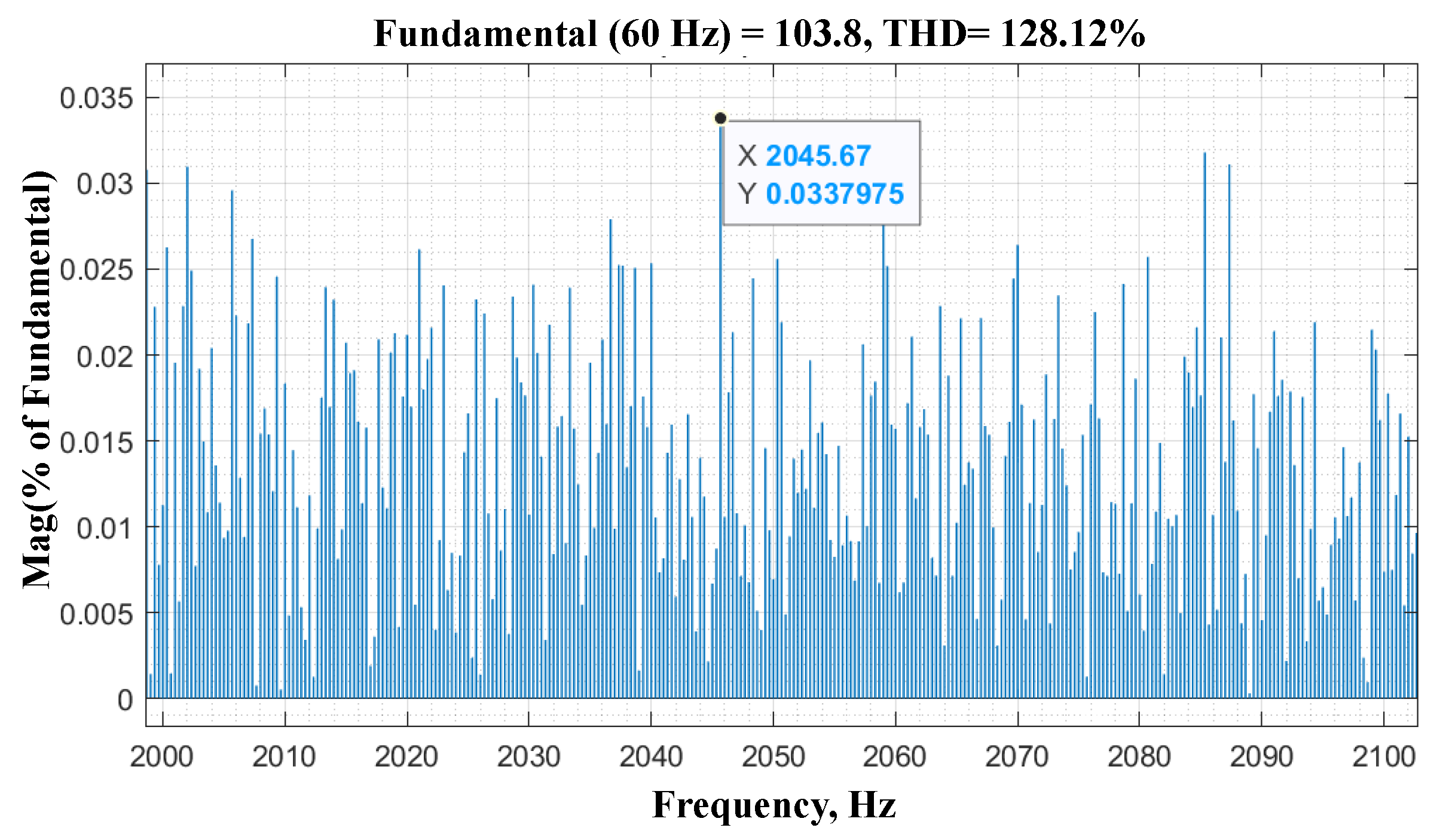
| Total DC kW | Module Size (W) | PV Module Number | Capacity per Inverter (kW) | Inverter Brand | Inverter Size (kW) | Inverter Number | Capacity Net Inverter (kW) | Capacity Net Module (kW) | DC/AC Ratio |
|---|---|---|---|---|---|---|---|---|---|
| 1412.33 | 315.46 | 2 × 1520 | 25.22 | SMA | 24 | 6 | 144 | 151.321 | 1.05 |
| 315.46 | 1 × 1340 | 31.525 | SMA | 24 | 40 | 960 | 1261.012 | 1.31 |
| Supraharmonics (2000–2100), Hz Attributes | |||
|---|---|---|---|
| Irradiance Cases | THD, % | Highest Magnitude, % | Irradiance − SH Correlation |
| Low, fixed, 200 W/m | 123.35 | 0.0485 | Low, high |
| High, fixed, 800 W/m | 14.77 | 0.012 | High, low |
| Varying, 12 May 2022 | 128.12 | 0.034 | Varying, high |
Disclaimer/Publisher’s Note: The statements, opinions and data contained in all publications are solely those of the individual author(s) and contributor(s) and not of MDPI and/or the editor(s). MDPI and/or the editor(s) disclaim responsibility for any injury to people or property resulting from any ideas, methods, instructions or products referred to in the content. |
© 2023 by the authors. Licensee MDPI, Basel, Switzerland. This article is an open access article distributed under the terms and conditions of the Creative Commons Attribution (CC BY) license (https://creativecommons.org/licenses/by/4.0/).
Share and Cite
Roy, S.; Debnath, A.; Tariq, M.; Behnamfar, M.; Sarwat, A. Characterizing Current THD’s Dependency on Solar Irradiance and Supraharmonics Profiling for a Grid-Tied Photovoltaic Power Plant. Sustainability 2023, 15, 1214. https://doi.org/10.3390/su15021214
Roy S, Debnath A, Tariq M, Behnamfar M, Sarwat A. Characterizing Current THD’s Dependency on Solar Irradiance and Supraharmonics Profiling for a Grid-Tied Photovoltaic Power Plant. Sustainability. 2023; 15(2):1214. https://doi.org/10.3390/su15021214
Chicago/Turabian StyleRoy, Sukanta, Anjan Debnath, Mohd Tariq, Milad Behnamfar, and Arif Sarwat. 2023. "Characterizing Current THD’s Dependency on Solar Irradiance and Supraharmonics Profiling for a Grid-Tied Photovoltaic Power Plant" Sustainability 15, no. 2: 1214. https://doi.org/10.3390/su15021214
APA StyleRoy, S., Debnath, A., Tariq, M., Behnamfar, M., & Sarwat, A. (2023). Characterizing Current THD’s Dependency on Solar Irradiance and Supraharmonics Profiling for a Grid-Tied Photovoltaic Power Plant. Sustainability, 15(2), 1214. https://doi.org/10.3390/su15021214









